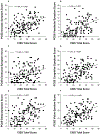Association between post-concussion symptoms and oculomotor deficits among adolescents
- PMID: 34383619
- PMCID: PMC8487965
- DOI: 10.1080/02699052.2021.1959065
Association between post-concussion symptoms and oculomotor deficits among adolescents
Abstract
Purpose: To examine the association between Post-Concussion Symptom Scale (PCSS) scores, Convergence Insufficiency Symptom Survey (CISS) scores, and oculomotor deficits post-concussion.
Methods: Records of adolescent patients examined in a multidisciplinary concussion clinic between July 2014 and May 2019 were reviewed. PCSS and CISS scores, results of eye examination and oculomotor assessment, concussion history, and demographics were abstracted.
Results: One hundred and forty patient records (median age, 15.3 years; 52 males, presented 109 days (median) from their most recent concussion) met inclusion criteria. Mean total scores on PCSS and CISS were 46.67 ± 25.89 and 27.13 ± 13.22, respectively, and were moderately correlated with each other (r = 0.53, p < .001). Oculomotor deficits were observed in 123 (88%) patients. Step-wise linear regression identified increased PCSS total score to be significantly associated with decreased amplitude of accommodation (p < .001). Increased CISS total score was significantly associated with receded near point of convergence, developmental eye movement test error scores, and cause of concussion.
Conclusion: High PCSS scores may indicate an accommodation deficit and thus prompt an oculomotor assessment in patients following a concussion. Using the CISS and a detailed oculomotor assessment may reveal underlying oculomotor deficits, which may benefit from treatment.
Keywords: Concussion; adolescent; symptom surveys; vision.
Figures





References
-
- Barr WB, McCrea M. Sensitivity and specificity of standardized neurocognitive testing immediately following sports concussion. J Int Neuropsychol Soc. 2001;7(6):693–702. Epub 2001/09/29. - PubMed
Publication types
MeSH terms
Grants and funding
LinkOut - more resources
Full Text Sources
Medical
Miscellaneous
